Home Decor
7 Feng Shui Tricks That Will Turn Any Room Into a Relaxing Retreat
Prepare to transform your space with 7 Feng Shui tricks that create tranquility—discover how to elevate your relaxation experience today!

To turn any room into a relaxing retreat, start by decluttering to allow clear energy flow. Choose soothing color palettes like soft blues and greens for a calm atmosphere. Optimize lighting with warm tones and natural sources to enhance comfort. Incorporate natural elements, like plants or a small water feature, to create a more grounded space. Mindfully arrange your furniture to encourage openness and smooth movement. Finally, personalize your space with meaningful decor. These simple Feng Shui tricks will elevate your relaxation experience. Stick around to discover even more transformative tips for your sanctuary!
Key Takeaways
- Decluttering your space fosters mental clarity and emotional stability, creating a peaceful environment for relaxation.
- Choosing soothing color palettes with soft, neutral shades promotes serenity and tranquility in any room.
- Optimizing lighting by using warm tones and layering sources enhances comfort and sets a cozy atmosphere.
- Incorporating natural elements, such as plants and water features, connects your space to nature and promotes positive energy.
- Mindfully arranging furniture to ensure open pathways encourages smooth movement and enhances the overall energy flow in the room.
Declutter for Clear Energy
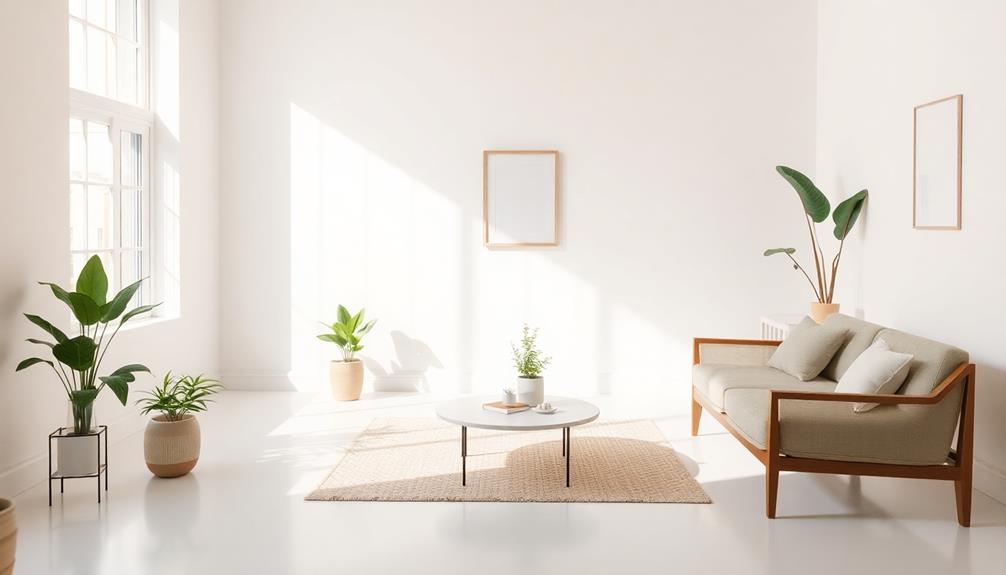
How can you create a more relaxing environment in your home? Start by decluttering for clear energy. Clutter can create chaos and hinder relaxation, so it's crucial to remove unnecessary items. By doing this, you not only improve your physical space but also promote emotional stability.
A clean environment fosters mental clarity, enhancing well-being and allowing you to enjoy a tranquil atmosphere. Consider adding vibrant colors and intricate patterns through Indonesian decorative pillows to elevate the aesthetic while maintaining comfort.
Next, organize your belongings. Utilize effective storage solutions to keep your space tidy, making it easier to access and appreciate the items that truly matter. This organization helps maintain positive energy flow, creating a harmonious space that promotes relaxation and high vibrations.
Don't forget to create open areas for activities and movement. This encourages energy flow and helps cultivate a serene and inviting retreat.
Choose Soothing Color Palettes

Choosing soothing color palettes is essential for creating a relaxing retreat in your home. Soft, neutral colors like cream, pale yellow, and peach foster relaxation and establish a serene environment. Calming shades, such as blues and greens, evoke tranquility, making them perfect for spaces where you unwind. While bright colors can energize, use them sparingly to maintain a calming atmosphere.
To help you select the best colors for your retreat, here's a quick reference table:
| Color Type | Description |
|---|---|
| Neutral Colors | Promote relaxation and create a serene environment |
| Calming Shades | Associated with tranquility, ideal for rest |
| Earth Tones | Foster grounding and stability for peace |
Incorporating these soothing color palettes will enhance your space, promoting balance and harmony. Earth tones, particularly browns and soft greens, can greatly contribute to a sense of grounding and stability. By thoughtfully choosing your colors, you can transform any room into a haven of relaxation, aligning with the principles of Feng Shui to create a truly inviting retreat.
Optimize Lighting for Comfort
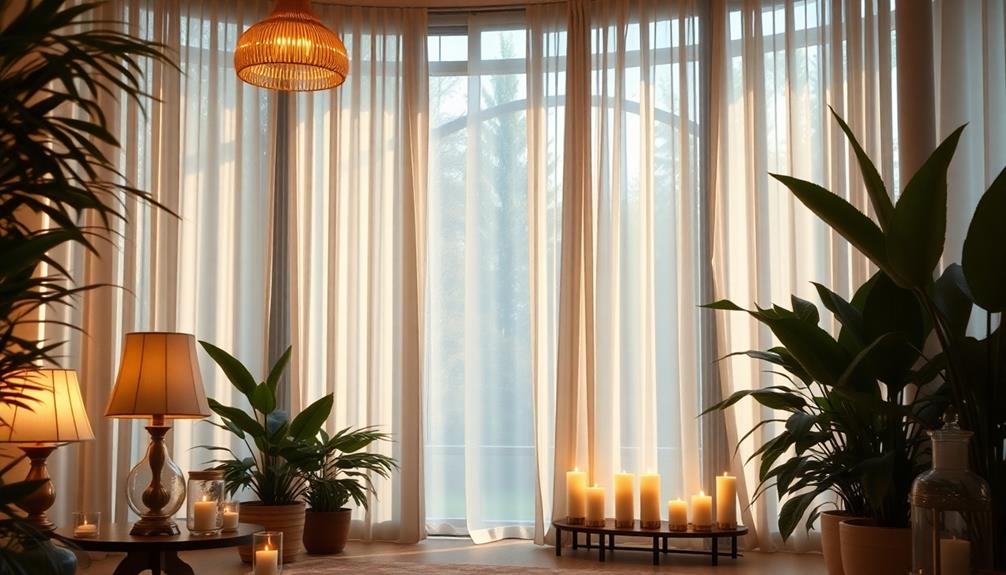
To create a truly relaxing retreat, focus on warm lighting that makes you feel cozy and secure.
Incorporating natural materials like wood and stone can enhance the warmth of your space, echoing the essence of Balinese design characteristics.
Don't forget to maximize natural light during the day by keeping your windows clear, as sunlight can greatly boost your mood.
Warm Light Benefits
Creating a cozy atmosphere in your retreat is all about the right lighting, and warm light plays an essential role in achieving that comfort. Warm lighting, like yellow bulbs in lamps, helps promote relaxation, making your space feel soothing rather than harsh. This gentle illumination fosters an inviting atmosphere, enhancing your sense of security and tranquility.
Incorporating natural materials like wood and textiles can further complement the warmth of your lighting, echoing the principles of traditional Indonesian style home decor.
To optimize your lighting for comfort, consider layering different sources—think table and floor lamps. This setup allows for adjustable brightness, so you can easily switch from bright light for tasks to soft, ambient lighting for unwinding in the evening. Adding dimmer switches further enhances this flexibility, letting you create a peaceful environment tailored to your mood.
While you focus on warm light, don't forget the importance of natural light during the day. It boosts energy throughout your space and elevates your mood. Maximize window access and keep curtains open to let the sun's warmth flow in, complementing your warm lighting strategy.
Natural Light Importance
Harnessing the power of natural light can dramatically elevate the comfort and ambiance of your retreat. In designs that embrace modern tropical aesthetics, the integration of large windows helps to blend indoor and outdoor environments, fostering a serene atmosphere.
When you incorporate natural light into your space, you not only boost your mood but also enhance your energy levels, creating a positive flow of energy throughout the room. This sense of balance can improve your overall well-being and promote relaxation.
To optimize the benefits of natural light, consider these tips:
- Install large windows or skylights to maximize sunlight intake, fostering an open atmosphere.
- Use sheer window treatments that let sunlight filter in while maintaining privacy, creating a cozy environment.
- Strategically position mirrors to reflect natural light, amplifying brightness and uplifting the space.
- Arrange furniture to embrace light sources, ensuring that every corner benefits from the glow of the sun.
Incorporate Natural Elements
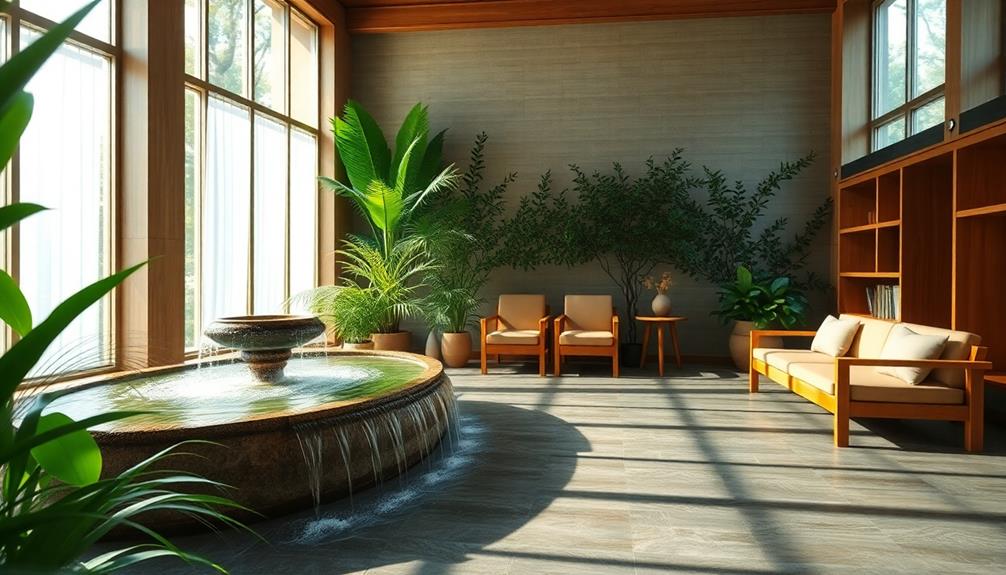
Incorporating natural elements into your retreat can transform the space into a sanctuary of relaxation. By introducing plants, natural materials, and water features, you can create a peaceful environment that enhances your overall well-being. Here's how you can do it:
| Element | Benefits | Tips |
|---|---|---|
| Large Plants | Improve air quality, create grounding energy | Position them near windows for sunlight |
| Natural Materials | Promote a soothing atmosphere, connect you to nature | Use wood, stone, and wool in decor |
| Water Features | Introduce calming sounds, enhance positive energy | Consider a small fountain for serenity |
Position plants and flowers strategically to attract positive energy and invigorate the space. Fresh flowers can add vibrancy, while a view of nature or nature-inspired artwork fosters a connection to the outdoors. Water elements, like a small fountain, introduce soothing sounds that create a serene ambiance, enhancing the flow of positive energy (Chi). By thoughtfully incorporating these natural elements, you can cultivate a soothing atmosphere that supports relaxation and tranquility in your retreat.
Arrange Furniture Mindfully

After you've brought natural elements into your retreat, the next step is to arrange your furniture mindfully. By thoughtfully positioning your pieces, you can create a space that nurtures positive energy and enhances the overall flow in the room. Incorporating decor like traditional artistry through Indonesian masks can further enrich the ambiance with vibrant colors and cultural significance.
Here are a few tips to keep in mind:
- Position larger furniture against solid walls for stability and support.
- Use rounded-edge furniture to encourage smooth energy flow.
- Arrange seating in a circular or semi-circular formation to foster conversation and connection.
- Maintain proportionality between furniture and room size for a balanced environment.
Consider how each piece serves a clear purpose, contributing to the harmony of the space.
When arranging your furniture, ascertain that movement is easy and unobstructed, creating a sense of freedom and comfort. This approach not only enhances the energy in the room but also promotes relaxation.
Create Calm Pathways

To create calm pathways in your space, guarantee they're free of obstacles for smooth movement and a natural flow of energy.
Arranging your furniture in a way that promotes openness can mirror the traditional Rumah Adat design, which emphasizes elevated structures and community space.
Make it easy to navigate without feeling crowded.
Regularly declutter these areas and consider adding natural elements like plants to enhance tranquility and connect with nature.
Clear Pathway Design
Creating clear pathways in your home is essential for fostering a calming environment. An unobstructed design promotes free movement and enhances energy flow, allowing Chi to circulate smoothly throughout your space.
Incorporating elements such as a Face Indonesian Decor Mask can further enhance the aesthetic appeal while celebrating rich cultural heritage. By carefully arranging your furniture and decor, you can create a relaxing atmosphere that feels open and inviting.
To achieve effective clear pathway design, consider these tips:
- Position furniture away from walkways to avoid feelings of confinement.
- Use natural elements like plants or decorative screens to subtly define pathways while maintaining openness.
- Avoid placing large furniture pieces directly in the line of sight to prevent visual blockages.
- Regularly declutter pathways to maintain a clean and orderly environment, supporting mental clarity and relaxation.
Encourage Natural Flow
Encouraging natural flow in your home enhances the calming atmosphere established through clear pathways. To promote relaxation, guarantee that these pathways are unobstructed, allowing energy (Chi) to move freely throughout the room.
When arranging furniture, create inviting pathways that encourage movement and interaction, avoiding any blockages that could lead to stagnant energy. Consider incorporating vibrant floral displays inspired by Indonesian wedding decor ideas to add a touch of nature and color, fostering a more serene environment.
Be mindful of large furniture pieces; placing them directly in the line of sight of doorways can disrupt the natural flow and create feelings of confinement. Instead, opt for soft, rounded furniture designs that enhance comfort and facilitate a gentle flow of energy in your home.
Incorporating natural elements, such as plants or decorative screens, can visually guide movement while maintaining open pathways. These elements also contribute to a calming ambiance, promoting a sense of peace and relaxation.
Personalize Your Space

Personalizing your space can transform it into a true reflection of who you are. Surround yourself with personal items, like family photos or artwork, that evoke positive memories and emotions. This creates a comforting atmosphere that promotes relaxation and tranquility.
Incorporate sentimental objects that tell your story or represent your aspirations to enhance emotional connection and foster a sense of belonging. Consider adding unique decor pieces, such as Indonesian decor masks, which not only enhance aesthetic appeal but also serve as conversation starters that celebrate cultural heritage.
To truly personalize your space, consider the following:
- Choose colors and textures that resonate with you, ensuring a harmonious environment.
- Infuse your environment with favorite books or travel souvenirs to inspire joy and creativity.
- Regularly reassess your decor by incorporating seasonal changes or new personal items to maintain ideal energy flow.
- Create a dedicated corner for mindfulness practices, like meditation or reading, to enhance your sense of peace.
Frequently Asked Questions
What Is the Feng Shui Rule for Bedrooms?
In Feng Shui, position your bed in the Command Position for security and visibility. Choose soft-edged furniture, calming colors, and limit electronics to create a serene space that promotes restful sleep and relaxation.
What Colors Should Be Avoided in Feng Shui?
You should avoid overly vibrant colors, heavy dark shades, excessive reds, and clashing hues in your space. These colors can create discomfort, unease, and disrupt the calm atmosphere you're aiming to achieve.
What Is the Feng Shui Room Theory?
The Feng Shui Room Theory focuses on arranging your space to enhance energy flow. By considering each room's purpose, decluttering, and personalizing your decor, you create an environment that promotes balance, relaxation, and well-being.
What Is Bad Feng Shui for a Living Room?
Bad feng shui for your living room includes overcrowding with furniture, harsh lighting, and clutter. Avoid positioning furniture facing away from the entrance, and be cautious with mirrors to maintain positive energy and tranquility.
Conclusion
By embracing these feng shui tricks, you're not just transforming a room; you're crafting your personal oasis of tranquility! Imagine stepping into a space so serene that stress evaporates like a puff of smoke, leaving only bliss behind. With decluttering, soothing colors, and natural elements, you'll find yourself floating on clouds of calm every time you enter. So go ahead, turn your home into a haven—because who wouldn't want to live in a paradise of relaxation?
Home Decor
How to Feng Shui Your Home for a Peaceful and Balanced Space
You can transform your home into a harmonious sanctuary, but discover the essential steps to achieve true balance and serenity within your space.
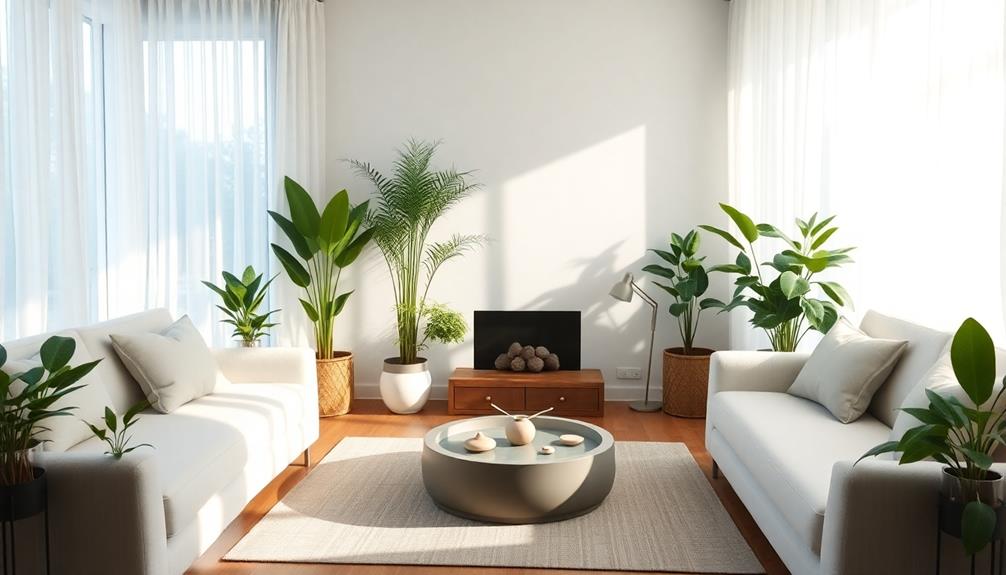
To Feng Shui your home for a peaceful and balanced space, start by decluttering to clear stagnant energy and enhance flow. Use the Bagua map to align areas of your home with key life aspects like wealth and health, choosing colors that promote positivity—blues for wealth, reds for reputation. Incorporate natural materials and soft, neutral colors to create a calming environment. Position furniture in commanding spots to foster security and control. Add plants for liveliness and improved air quality. With these principles in mind, you can create a serene sanctuary that supports your well-being—there's even more to explore on this journey.
Key Takeaways
- Declutter regularly to remove stagnant energy and promote a serene atmosphere throughout your home.
- Use the Bagua Map to identify areas of your home that correspond with specific life aspects for targeted enhancement.
- Incorporate plants and natural materials to improve air quality and establish a connection with nature.
- Choose soft, neutral colors to create a calming environment while avoiding overwhelming bright tones.
- Arrange furniture in commanding positions to foster a sense of control and security in your living space.
Understanding Feng Shui Principles
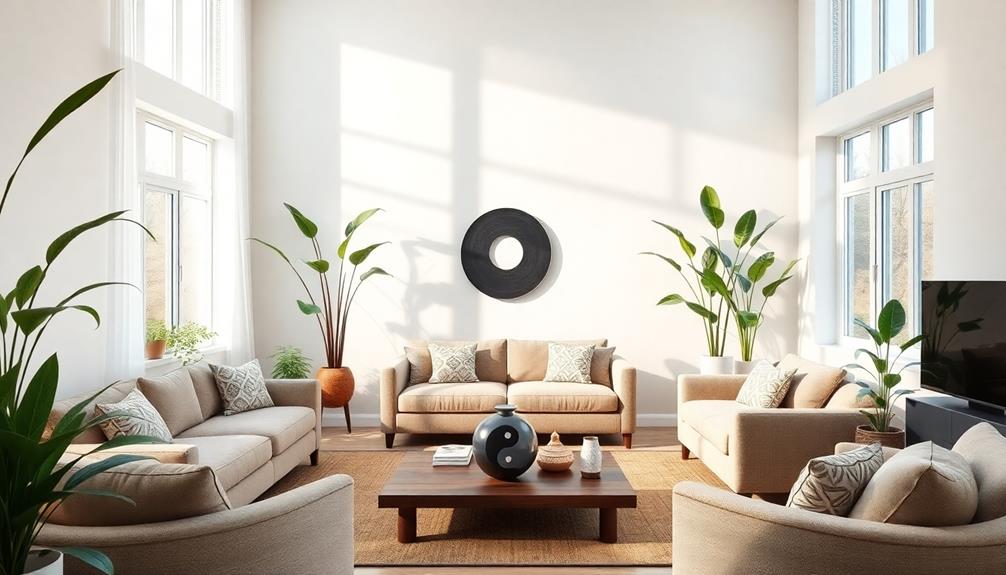
Understanding Feng Shui principles can transform your living space into a sanctuary of balance and positivity. At the heart of Feng Shui is the concept of energy flow, or chi, which influences how you feel in your environment.
To create harmony and balance, start by decluttering your spaces. This practice clears out stagnant energy, allowing chi to flow freely, promoting a sense of well-being. Incorporating elements like Indonesian decorative pillows can enhance comfort while reflecting cultural heritage, further enriching the energy of your home.
Next, familiarize yourself with the five elements of Feng Shui: fire, earth, metal, water, and wood. Each element carries unique qualities that need to be balanced throughout your home.
Consider how color selection affects energy; for instance, blue can boost wealth energy, while red can enhance your reputation.
Using a Bagua map can further guide your decor choices, aligning specific areas of your home with aspects of your life, such as health and relationships.
By integrating these principles of Feng Shui into your living space, you can cultivate a harmonious environment that nurtures positivity and enhances your overall quality of life.
Embrace these techniques, and you'll notice a profound transformation in how your home feels and functions.
Using the Bagua Map
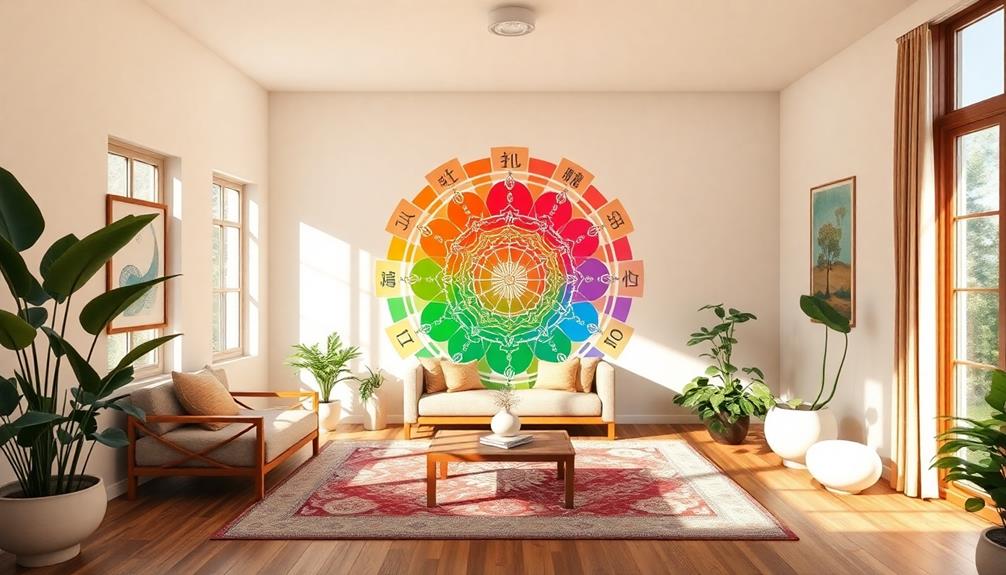
The Bagua Map serves as a powerful tool for enhancing specific areas of your life through intentional design. This map is divided into nine areas, each representing different aspects of life like Wealth, Love, and Health. By aligning the Bagua Map with the compass directions in your home, you can promote a positive energy flow and create a harmonious home.
Here's a quick overview of the Bagua areas:
| Area | Element | Color |
|---|---|---|
| Wealth | Wood | Purple |
| Love | Fire | Pink |
| Health | Earth | Yellow |
| Career | Water | Black |
| Family | Wood | Green |
| Knowledge | Earth | Blue |
| Fame | Fire | Red |
| Helpful People | Metal | Grey |
| Creativity | Metal | White |
To effectively use the Bagua Map, focus on the placement of furniture and decor that resonate with each area. Regularly assess the energy flow and clear clutter to enhance specific life areas, promoting balance in your space. With these Feng Shui principles, you'll cultivate a vibrant and positive environment.
Practical Feng Shui Tips

When you incorporate practical Feng Shui tips into your home, you'll create a space that not only looks great but also feels harmonious and inviting.
Start by decluttering your environment regularly; this enhances energy flow and fosters a calm atmosphere. Remember, clutter can contribute to stagnation and chaos, so keep your space tidy.
Emphasizing natural materials like wood and stone in your decor can further enhance the peaceful vibe of your home, creating a connection with nature that aligns with Balinese design concepts.
Opt for soft, neutral colors in your Feng Shui decor to promote relaxation and a soothing vibe. Avoid overwhelming bright colors, as they can heighten anxiety.
Incorporating plants is another significant strategy; they improve air quality and connect your home with natural elements, enhancing liveliness and harmony.
Furniture placement is essential; position your bed and desk in commanding positions where you can see the entrance. This creates a sense of control and security within your peaceful space.
Finally, optimize your lighting by using soft, warm bulbs and adjustable dimmers. This allows you to create a comfortable ambiance tailored to different activities and moods, achieving balance in your environment.
Creating Serene Spaces
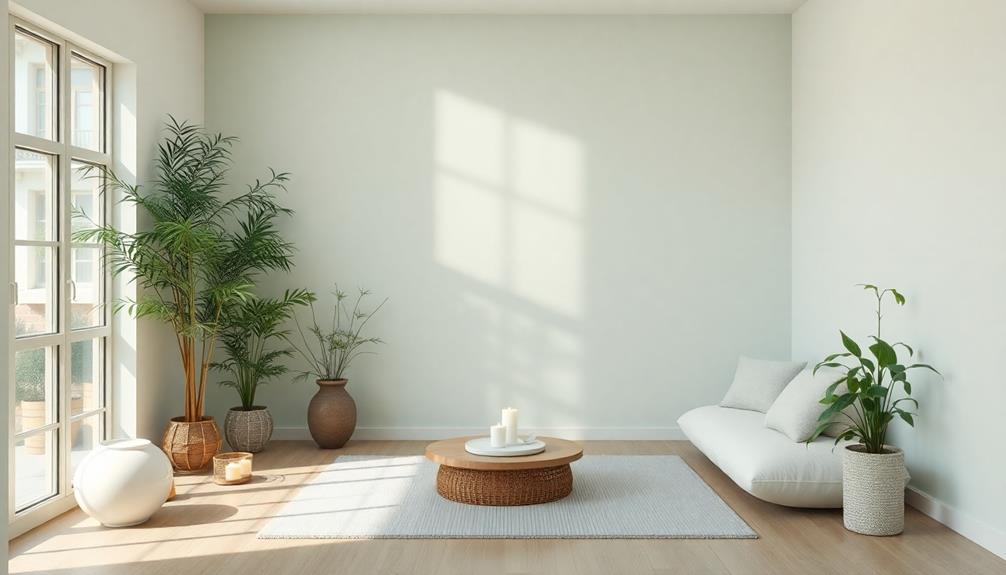
Creating serene spaces in your home is all about fostering an atmosphere that promotes relaxation and harmony. To achieve this, you need to declutter regularly. Removing unnecessary items eliminates stagnant energy, allowing for a smoother flow of chi throughout your home, which enhances tranquility and calmness.
Incorporating elements of traditional Indonesian style home decor can additionally enhance this ambiance by using natural materials and intricate designs that reflect a connection to nature.
Incorporating soft colors is another important element. Use neutral and pastel palettes to create harmony and reduce stress levels. Moreover, bring nature indoors by adding plants and natural elements; they enhance liveliness and improve air quality, contributing to a serene atmosphere.
Optimizing lighting is essential, too. Implement soft, warm lighting and maximize natural light through your windows to create a peaceful ambiance that supports relaxation.
In addition, establish calming focal points in each room, such as a piece of art or a natural element. These focal points anchor the space and promote balance.
Incorporating Nature and Color
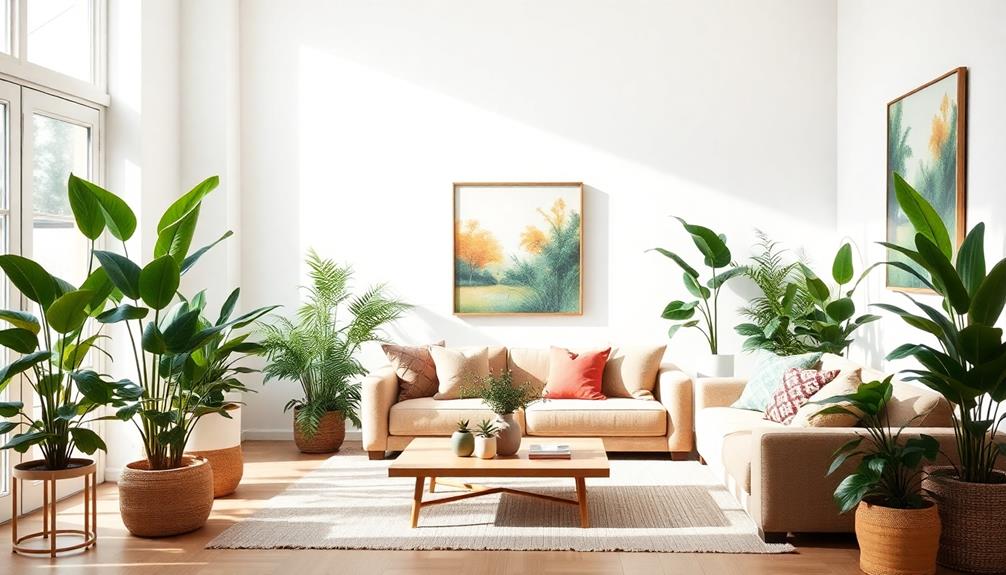
Incorporating nature and color into your home can transform your space into a sanctuary of peace and energy. To enhance overall liveliness, start by integrating plants, which not only improve air quality but also promote positive energy flow in Feng Shui.
Consider adding vibrant artistry through decorative pieces like Indonesian decor masks, which can serve as unique focal points that tell stories of local traditions. Choose greenery that resonates with you; it'll create a connection to nature that fosters tranquility.
When it comes to color choices, consider using hues that align with the five Feng Shui elements. Soft blues and greens reflect wood and water, encouraging growth and calmness, while warm earth tones ground your space and instill a sense of stability.
Paint your walls in muted tones to evoke a serene environment, perfect for relaxation.
Don't forget to incorporate natural elements like wood furniture and stone decor. These materials establish a harmonious balance and connect your interior with the outdoors.
Maximize natural light in your home, as it brightens spaces and enhances the vibrancy of your color choices, fostering an uplifting atmosphere.
Frequently Asked Questions
How to Organize Your Home According to Feng Shui?
To organize your home according to feng shui, start by decluttering to enhance energy flow. Use the Bagua Map to align areas, arrange furniture for visibility, and incorporate natural elements for balance and liveliness.
How to Bring Positive Energy Into Your Home Feng Shui?
To bring positive energy into your home, declutter regularly, incorporate natural elements, and choose calming colors. Arrange furniture for ideal flow, ensuring each space promotes tranquility and liveliness, enhancing your overall well-being.
What Are the Feng Shui Rules for a House?
To create harmony in your house, declutter regularly, position furniture for ideal flow, use soft colors, maximize natural light, and incorporate plants. These feng shui rules help you cultivate a balanced, peaceful environment.
How to Tell if a House Has Good Feng Shui?
As you step inside, notice the light flooding through clean windows and the clear path welcoming you. If energy flows freely, furniture is positioned for control, and nature thrives, your house likely embodies good Feng Shui.
Conclusion
By embracing the principles of Feng Shui, you're not just rearranging furniture; you're planting seeds of harmony in your home. Picture your space as a garden—each element nurtured to flourish together. As you invite balance and peace, watch how your environment transforms into a sanctuary. Just like a gentle breeze rustles through leaves, your energy will flow freely, creating a tranquil haven that nourishes your spirit. Embrace these changes, and let serenity bloom in every corner of your life.
Home Decor
The Feng Shui Color Palette That Will Bring Instant Harmony to Your Home
Unlock the secrets of a harmonious home with the perfect Feng Shui color palette and discover how each shade can transform your space.
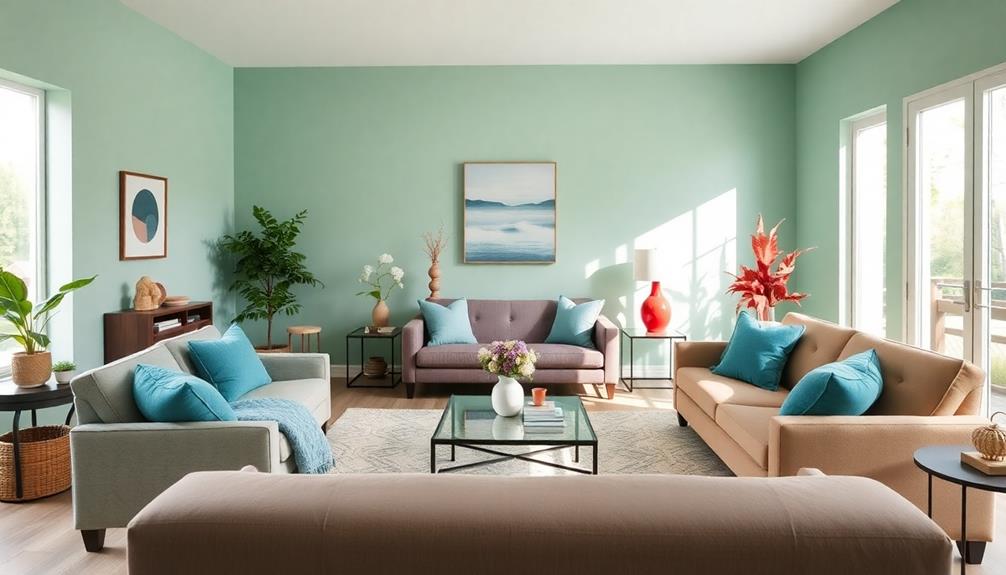
To bring instant harmony to your home, focus on using the right Feng Shui color palette. Start with calming blues and greens in bedrooms for relaxation, while vibrant reds and oranges can energize kitchens and living rooms. Integrate earth tones like beiges and light yellows in common areas to foster comfort and stability. For workspaces, utilize metallics and whites to boost clarity. By thoughtfully selecting colors that align with their functions, you'll create a nurturing atmosphere. Explore how other colors can enhance energy flow and mood throughout your space for an even more tranquil environment.
Key Takeaways
- Color influences energy in spaces; choose hues that align with the function of each room for harmonious living.
- Use calming blues and greens in bedrooms and bathrooms to promote relaxation and restful sleep.
- Warm colors like reds and oranges in kitchens stimulate appetite and create a welcoming atmosphere.
- Earth tones in living rooms foster stability and social interaction, enhancing comfort and community.
- Incorporate natural elements and optimize natural light to enhance tranquility and balance in your home.
Understanding Feng Shui and Color

When you immerse yourself in the world of Feng Shui, you'll discover how color plays an essential role in shaping the energy of your living spaces. By understanding Feng Shui principles, you can harness the power of colors to create environments that promote balance and well-being.
Each color corresponds to one of the five elements—Wood, Fire, Earth, Metal, and Water—allowing you to influence the mood and atmosphere within your home. For instance, incorporating natural materials in your decor can enhance the overall harmony of the space, aligning well with traditional Indonesian style home decor.
For instance, blues and blacks are tied to the Water element, promoting calmness and abundance, making them ideal for spaces where you seek serenity. On the other hand, reds and oranges represent the Fire element, energizing your rooms and enhancing passion.
This interplay of colors can transform how you feel in your spaces; warm colors invigorate, while cool colors soothe.
Choosing the right colors for specific rooms is vital. Use soothing greens in bedrooms to foster restful energy and earth tones in kitchens to minimize conflict.
The Five Element Color Breakdown
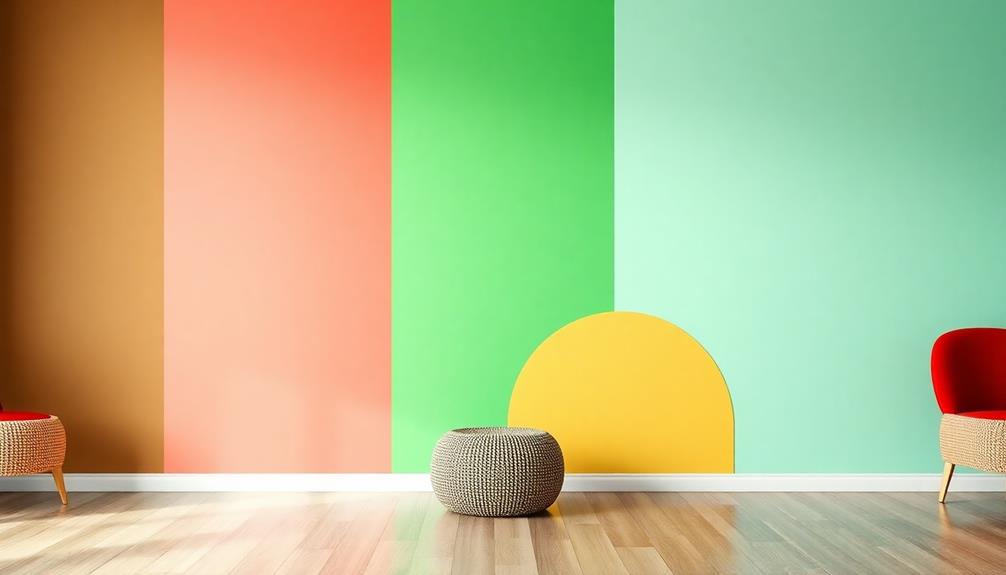
In Feng Shui, understanding the colors tied to the Five Elements can transform your space.
Fire colors like red and orange energize, while water hues such as blue promote calmness and harmony.
Incorporating natural materials, as seen in Balinese design principles, enhances the energetic flow of your home.
Earth tones offer stability, creating a nurturing environment that enhances your overall well-being.
Fire Element Colors
The vibrant colors of the Fire element in Feng Shui, including Red, Orange, Purple, Pink, and Strong Yellow, bring passion and energy to your space. By incorporating these fire element colors into your decor, you can enhance positive energy and create a more harmonious environment.
For instance, using vibrant decorative pillows crafted from traditional fabrics like Batik can seamlessly blend these colors into your living space while celebrating cultural heritage Indonesian Decorative Pillows. These colors are particularly effective in areas like the living room, kitchen, and workspace, where you want to stimulate energy and warmth.
However, be mindful of using these colors in moderation. While they can boost your mood and productivity, excessive application may lead to increased arguments or tensions. To achieve a balanced atmosphere, combine fire element colors with cooler tones, which can help mitigate potential overstimulation while still reaping the benefits of their vibrancy.
When selecting fire colors, consider their psychological effects. For instance, Red can stimulate appetite and excitement, making it ideal for social spaces.
Water Element Colors
Colors associated with the Water element, such as Blue and Black, create a serene and rejuvenating atmosphere in your home. These water element colors symbolize calmness and purity, promoting emotional stability and balance in your energy flow. When used thoughtfully, they enhance family harmony and interpersonal relationships, making your space feel more inviting.
To help you visualize how to incorporate these colors, here's a quick reference:
| Color | Symbolism | Best Spaces |
|---|---|---|
| Dark Blue | Calmness, Depth | Bathrooms, Offices |
| Black | Sophistication, Power | Living Rooms, Bedrooms |
| Deep Navy | Tranquility, Stability | Dining Areas |
Incorporating shades of dark blue and black into your decor can transform spaces like bathrooms and home offices, creating a soothing retreat. Remember to avoid light blues and cyans, as they don't resonate with the Water element's energy. By mindfully selecting these colors, you'll cultivate an environment that fosters tranquility and rejuvenation, making your home a sanctuary of calmness.
Earth Element Colors
Moving from the calming hues of the Water element, earth element colors bring a sense of stability and nourishment to your home. These hues, including light yellow, beige, and sandy tones, create a nurturing environment that fosters comfort and tranquility.
Incorporating elements like traditional artistry through decor masks can enhance the aesthetic appeal and cultural richness of your space. By integrating earth element colors into your decor, you enhance health and protection in your relationships, aligning with qualities of grounding and support.
Consider using these earthy tones in your bedrooms and living rooms, as they encourage relaxation and harmony. If any areas of your home feel chaotic or overly stimulating, earth colors can help balance the energy, promoting a sense of peace.
Integrating these colors thoughtfully isn't just about aesthetics; it's essential for creating a balanced atmosphere that enhances overall well-being and good energy flow.
When you surround yourself with earth element colors, you invite a nurturing environment that supports both emotional and physical health.
Choosing Colors for Each Room

When choosing colors for each room, it's crucial to contemplate how different hues affect your mood and energy.
Each space in your home has unique needs and elemental associations that can guide your color selections. For example, in traditional Indonesian housing, specific colors may symbolize cultural significance and enhance the spiritual ambiance of a home.
Color Psychology Overview
In creating a harmonious living space, selecting the right colors for each room plays a crucial role in influencing emotions and behaviors.
Understanding the impact of Feng Shui colors can help you choose specific colors that align with the functions of each space. Additionally, incorporating elements of Indonesian cultural heritage through decor, such as vibrant masks, can enhance the emotional ambiance of a room.
- Bedrooms: Use soft blues and greens to promote rest and healing, enhancing your overall well-being.
- Kitchens: Incorporate warm colors like reds and oranges to stimulate appetite and create a welcoming atmosphere without overwhelming energy.
- Living Rooms: Thrive on earth tones and soft yellows that encourage relaxation and social interactions, making it a communal space.
- Bathrooms: Opt for whites and light blues to evoke cleanliness and rejuvenation, promoting a calming retreat.
Elemental Color Associations
Understanding the elemental color associations can transform your home into a harmonious oasis. By choosing the right colors for each room, you can create an environment that promotes balance and well-being. Here's a quick guide to help you select colors based on elemental associations:
| Element | Colors | Ideal Rooms |
|---|---|---|
| Fire | Reds, Oranges, Yellows | Living Room |
| Water | Calming Blues, Blacks | Bathrooms, Bedrooms |
| Wood | Greens, Browns | Home Offices, Nurseries |
| Metal | Whites, Greys, Metallics | Workspaces |
| Earth | Light Yellows, Beiges, Earthy Tones | Kitchens, Dining Areas |
For instance, the earth element helps create a nurturing kitchen environment, while metal element colors enhance clarity and productivity in your workspace. By thoughtfully integrating these colors, you can foster the desired energy in each room. Remember to avoid overusing vibrant fire colors in communal spaces to prevent heated arguments. Instead, focus on balance and harmony through these elemental color associations to truly elevate your home's atmosphere.
Room-Specific Color Choices
Choosing the right colors for each room can greatly impact your home's energy and ambiance. By aligning your color choices with Feng Shui principles, you can create a harmonious environment that enhances your well-being.
For instance, incorporating elements from luxury tropical design aesthetics can elevate your space while maintaining a peaceful atmosphere. Here are some effective color suggestions for different spaces:
- Bedroom: Calming blues and greens promote relaxation and improve sleep quality.
- Kitchen: Soft earth tones like beige and light yellow foster a nurturing atmosphere, while avoiding fiery reds helps keep tensions low.
- Living Room: Neutral colors, including soft yellows and earthy tones, encourage relaxation and social interaction.
- Bathroom: Whites and light blues create a sense of cleanliness and rejuvenation.
When you apply these colors, you'll notice how they work together to enhance the energy flow in your home. Using earth tones can ground your space, while blues and greens provide a soothing effect.
For your home office, whites and metallics boost clarity and productivity, making it easier to focus. By thoughtfully choosing colors for each room, you can create a balanced environment that reflects peace and harmony throughout your home.
Tips for Maintaining Balance
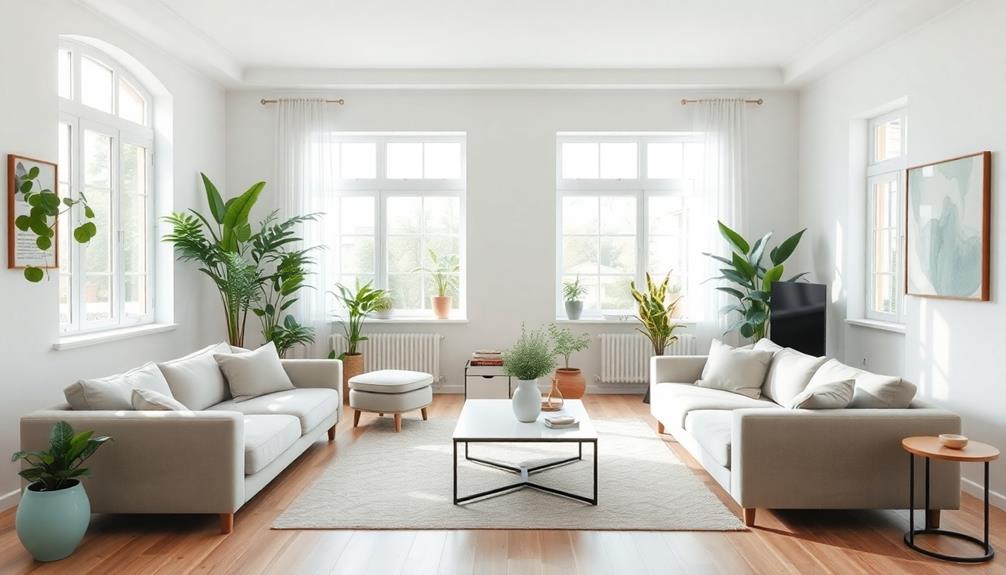
Striking a balance in your living spaces can greatly enhance your overall well-being.
In the bedroom, aim for a neutral color palette, like soft beiges or whites, to cultivate a calming atmosphere that encourages restful sleep. Incorporating elements of modern tropical aesthetics can further enhance the serene environment, as these designs often emphasize natural materials and open spaces. Balancing Yin and Yang here is vital, so keep it serene.
For your bathroom, introduce earth tones such as browns and soft yellows. These colors slow down energy flow, promoting relaxation and serenity.
In the kitchen, it's essential to limit fire colors like bright reds and oranges. Overusing these shades can create heightened tensions and arguments among family members. Instead, focus on a balanced approach that fosters a harmonious cooking environment.
For your living room, opt for neutral wall colors that allow flexibility in decor choices, creating a welcoming space for social gatherings.
To enhance the overall harmony of your home, incorporate artwork and accessories in specific colors that introduce targeted energy balances. This strategy not only maintains the balance you seek but also adds personality to your color palette.
Practical Applications of Color
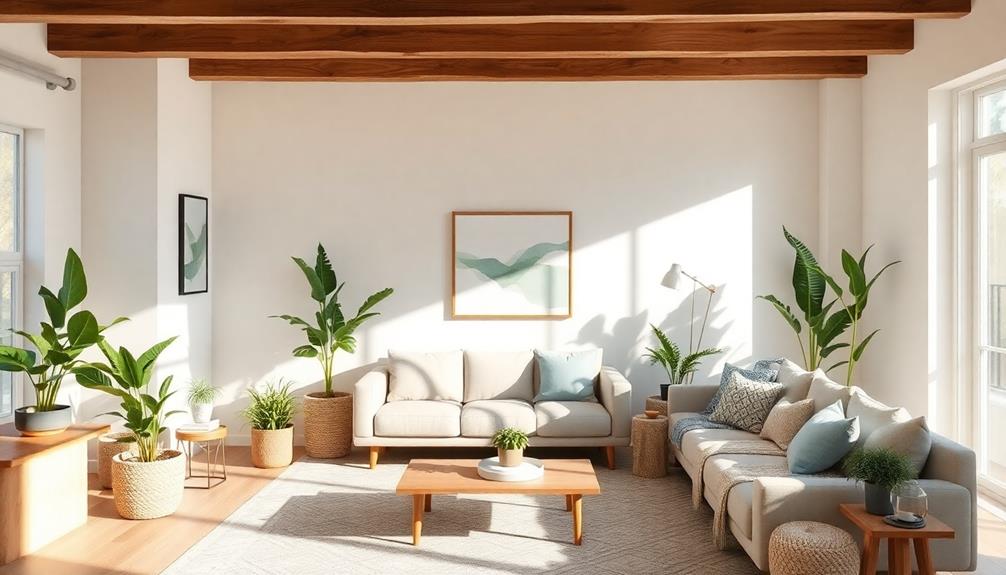
To create harmony in your home, practical applications of color play a significant role. By thoughtfully selecting paint colors that align with the principles of Feng Shui, you can enhance the energy flow and achieve balance in your space.
Here are some effective ways to apply color:
- Use calming colors like soft blues and greens in bedrooms and bathrooms to promote relaxation. Incorporating unique decor elements, such as Indonesian decor masks, can further enhance this tranquility with their cultural significance.
- Incorporate vibrant reds and oranges in kitchens to stimulate appetite and warmth.
- Choose earth tones such as browns and beiges for living rooms to foster a nurturing environment.
- Update your color schemes regularly to reflect your life changes and personal growth.
Additionally, consider incorporating natural elements like plants and water features. These not only complement your chosen paint colors but also enhance tranquility and balance.
Personalizing Your Color Choices

Your color choices can greatly influence the energy of your home, so personalizing them is crucial for creating a space that truly reflects who you are.
Start by evaluating your birth element, as each corresponds to specific colors that can enhance your unique energy and overall well-being. Understanding the psychological impact of colors helps you select hues that resonate positively with your emotions. For instance, incorporating vibrant colors like red and gold can evoke a festive ambiance, similar to Indonesian wedding decor.
Think about the atmosphere you want in each room—whether it's calming blues for relaxation or vibrant reds for energy.
Don't hesitate to experiment with different color combinations; this process can reveal your personal preferences and boost your comfort. By tailoring your color choices, you can create a harmonious living environment that feels just right for you.
Integrating natural elements like plants or flowers in your chosen palette can enrich the tranquility and balance of your space.
Also, remember to regularly update your color choices to reflect any changes in your life or mood. This practice not only keeps your home vibrant but also guarantees it remains energetically aligned with who you are.
Embrace your individuality through your colors!
Harmonizing With Nature
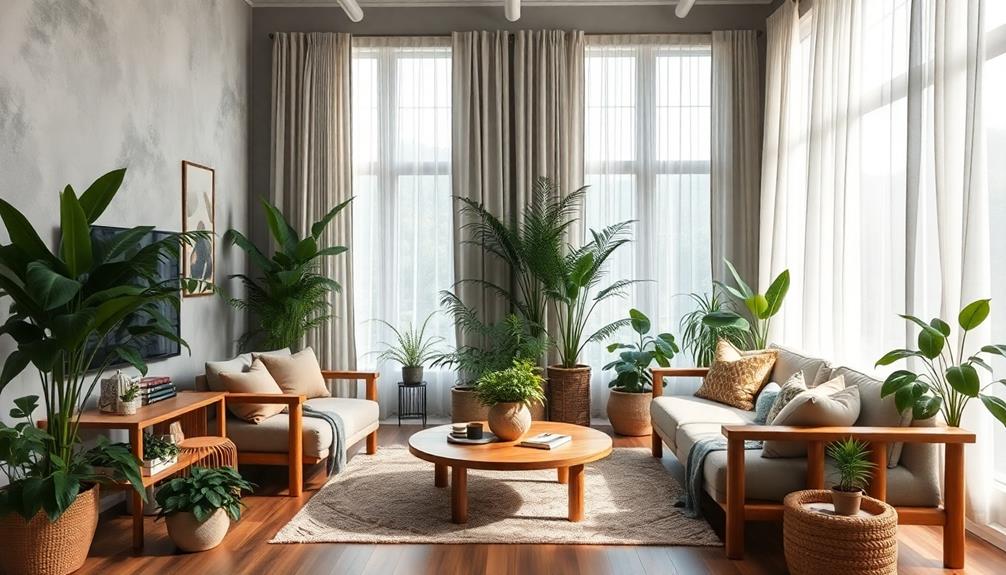
Incorporating elements from nature into your home can transform the energy of your space, fostering a deep sense of harmony and tranquility.
Embracing the Wood element and using earthy colors like greens and browns can create a grounding atmosphere, promoting stability and nourishment.
Here are some ways to harmonize with nature in your decor:
- Add plants: Incorporate various indoor plants to enhance liveliness and bring the healing energies of nature indoors.
- Use water features: Consider small fountains or aquariums that promote a calm and serene environment.
- Optimize natural light: Strategically place mirrors or furniture to maximize sunlight, enhancing energy flow throughout your space.
- Choose organic textures: Use natural materials and patterns in your decor to create a balanced and tranquil atmosphere.
Color Psychology in Feng Shui

Colors play an essential role in shaping the energy and mood of your space, making color psychology a significant aspect of Feng Shui. Each color embodies specific energies and emotions, influencing your environment's overall atmosphere.
In Feng Shui, colors correspond to the five elements—Wood, Fire, Earth, Metal, and Water—each carrying unique properties that can enhance various life aspects like wealth, health, and relationships.
For instance, if you're looking for relaxation, incorporating calming colors like blue and green in bedrooms or bathrooms can promote healing and tranquility. These hues help create a serene sanctuary, allowing you to unwind after a long day.
On the other hand, warm colors like red and orange can stimulate energy and passion, making them ideal for communal spaces like living rooms and kitchens. However, it's vital to balance these vibrant shades to prevent feelings of tension.
Transforming Your Space With Color

There's something magical about how colors can transform a space, creating an environment that resonates with your emotions and intentions.
By utilizing a balanced Feng Shui color palette, you can enhance energy flow in your home, promoting harmony and tranquility.
To create a nurturing environment, consider incorporating earthy tones like light yellow, beige, and soft orange. These colors align with the Earth element, fostering stability and health.
For spaces that require relaxation, like bedrooms and bathrooms, opt for calming colors such as soothing blues and greens. These hues resonate with the Water element, encouraging peace and serenity.
In more dynamic areas, like kitchens and living rooms, embrace bright colors like reds and oranges to stimulate energy and motivation. These vibrant shades align with the Fire element, enhancing social interactions.
To achieve a harmonious atmosphere, thoughtfully combine complementary colors based on Feng Shui principles. This approach not only boosts aesthetic appeal but also supports emotional well-being.
- Earthy tones for nurturing
- Calming colors for relaxation
- Bright colors for energy
- Complementary colors for harmony
Transform your space with the right colors, and watch how your environment shifts!
Frequently Asked Questions
What Color Brings Harmony?
To bring harmony, you should consider soft earth tones like beige and light yellow. These colors promote stability and nourishment, creating a balanced environment that fosters peace and tranquility in your living space.
What Is the Best Color for a House in Feng Shui?
Did you know that colors can influence mood and energy by 60%? For your house in Feng Shui, earthy tones like soft yellows create stability, while blues enhance wealth. Choose wisely for harmony and balance.
How to Bring Positive Energy Into Your Home Feng Shui?
To bring positive energy into your home, declutter frequently and maintain cleanliness. Incorporate calming colors in bedrooms and vibrant hues in kitchens. Use the Bagua map to strategically place colors that enhance specific energies.
Which Colour Brings Positivity at Home?
You'll feel like you're walking on sunshine with yellow! This vibrant color radiates joy and optimism, instantly brightening your home. Pair it with greens for growth or soft pinks for love to amplify positivity throughout your space.
Conclusion
Incorporating the right colors into your home can markedly enhance your well-being. Did you know that studies show 85% of people make purchasing decisions based on color? This statistic highlights the powerful impact color has on our emotions and choices. By thoughtfully selecting hues that align with Feng Shui principles, you can create a harmonious environment that not only looks good but also feels good. Embrace color to transform your space and nurture a balanced, inviting atmosphere.
Home Decor
The Ultimate Feng Shui Guide to Arranging Your Furniture for Balance
Find harmony and balance in your space with Feng Shui furniture arrangement tips that could transform your life—discover how to unlock positive energy today.

Arranging your furniture using Feng Shui principles creates balance and harmony in your space. Start by avoiding obstacles in doorways to guarantee energy flows freely. Position key pieces, like your bed and sofa, in a commanding spot where you can see the entrance. Use rounded furniture to soften sharp corners and create cozy zones for social interaction. Be mindful of clutter, as it restricts positive energy. Each room has unique strategies, from the bedroom to the office. Embracing these guidelines will enhance your well-being and invite more positive energy into your life. Discover more insights to elevate your space even further.
Key Takeaways
- Position key furniture like beds and sofas in commanding positions to enhance energy flow and promote restful environments.
- Maintain clear pathways and avoid clutter to ensure unobstructed energy movement throughout your space.
- Utilize rounded furniture edges to reduce negative energy and create a more harmonious atmosphere.
- Arrange seating in circular or U-shaped formations in living areas to encourage social interaction and connection.
- Incorporate natural elements like plants or water features to enhance balance and align with Feng Shui principles.
Understanding Feng Shui Principles

Often misunderstood, Feng Shui is an ancient Chinese practice that aims to optimize the flow of qi (chi) energy in your living spaces, promoting harmony and well-being. To create a harmonious living space, you need to grasp the principles of Feng Shui, which emphasize balance and harmony through the interaction of energy and elements.
Integrating elements of Balinese design characteristics can further enhance the serene atmosphere you seek. Central to these principles is the concept of Yin and Yang, representing the balance of opposing forces. You'll also want to reflect on the five elements of Feng Shui—wood, fire, earth, metal, and water—each contributing unique qualities to your environment. Understanding how these elements work together helps you enhance the overall energy flow in your home.
Utilizing the Bagua map is essential for analyzing your space and determining where to focus your efforts. By identifying key areas, you can arrange furniture and decor in ways that promote positive energy flow.
Additionally, clutter removal is vital; it clears pathways and allows qi to circulate freely, reinforcing the beneficial effects of your Feng Shui adjustments. Embracing these principles will help you cultivate a balanced, serene atmosphere that nurtures your well-being.
Key Rules for Furniture Placement

When arranging your furniture, it is crucial to follow some key rules that enhance the flow of qi in your space. Start by avoiding any obstacles in doorways and pathways; this guarantees the unobstructed flow of energy, creating a sense of openness. Position key furniture pieces, like your bed and sofa, in a commanding position, ideally facing the entrance. This arrangement fosters feelings of security and control, bringing in positive energy.
Next, maintain balance in furniture distribution across the room. This prevents energy stagnation, promoting a harmonious environment. Using rounded furniture edges can also help by reducing sharp corners that may harbor negative energy.
Finally, create cozy zones with your seating arrangements. This encourages conversation and social interaction, enhancing connection within your space.
| Key Rules | Benefits | Tips for Implementation |
|---|---|---|
| Avoid obstacles | Enhances flow of energy | Keep pathways clear |
| Commanding position | Promotes security and control | Face key pieces towards entry |
| Balanced distribution | Prevents energy stagnation | Distribute furniture evenly |
| Cozy zones | Fosters connection and community | Arrange seating for conversation |
Room-Specific Arrangement Strategies

Transform your space by applying room-specific arrangement strategies that cater to each area of your home.
In the bedroom, position your bed in a command position facing the door but not directly aligned with it. This promotes security and restful sleep, which is vital for your well-being. Incorporating elements like Indonesian decorative pillows can enhance comfort while reflecting cultural heritage.
For the living room, arrange your seating in a circular or U-shaped formation to create flow and encourage conversation, enhancing positive energy and interaction among guests.
In the kitchen, make certain the stove is in a command position, allowing you to see the entrance while cooking. Avoid aligning it directly with the sink and fridge to prevent elemental clashes that disrupt harmony.
The dining room should feature a round table centered in the space, fostering balance and harmonious living, while steering clear of placement between two access points to maintain good energy flow during meals.
Lastly, in your home office, position your desk where you can see the entrance. This arrangement not only fosters awareness but also gives you control over your work environment, enhancing productivity and energy flow.
Implement these strategies for a balanced and inviting home.
Common Mistakes to Avoid

Creating a harmonious space requires attention to common mistakes that can hinder your Feng Shui efforts. One major pitfall is allowing cluttered spaces to accumulate, which greatly restricts positive energy flow and creates chaos. Keep your areas organized, as this promotes balance and movement throughout your home. Another mistake involves neglecting the natural elements, such as light and air, which are essential for maintaining a balanced environment. Failing to incorporate these elements can be one of the reasons why your home feels off, leaving it stagnant and uninviting. Additionally, arranging furniture in a way that blocks doorways or pathways can disrupt the energy flow, further contributing to that uneasy feeling.
Additionally, incorporating natural materials like wood and bamboo can enhance the aesthetic appeal of your space while aligning with traditional Indonesian style home decor.
Another mistake is overcrowding rooms with excessive furniture. This not only limits movement but also leads to stagnant energy. Instead, choose pieces that fit the space appropriately, ensuring they enhance rather than hinder the atmosphere.
Be mindful of sharp corners in your furniture, as these can create negative energy points. Opt for rounded edges to promote safety and comfort in your living area.
Additionally, ignoring natural light and airflow can lead to stagnation. Arrange furniture to maximize these elements for an inviting environment.
Lastly, neglecting to align furniture with natural elements can disrupt harmony and balance. Incorporate plants or water features to enhance positive energy flow.
Benefits of Proper Placement

Proper furniture placement can greatly enhance your living space, promoting a sense of well-being and harmony. When you thoughtfully arrange your furniture according to Feng Shui principles, you create a balanced environment that fosters positive energy.
This arrangement allows the flow of energy to circulate freely, making your space feel inviting and uplifting. Incorporating elements like traditional artistry through decor masks can further enrich your home's ambiance, adding cultural depth and vibrancy.
A well-planned layout reduces stress levels and enhances your mood, contributing to harmonious living. In workspaces, proper placement boosts productivity and focus by ensuring clear pathways and a commanding position.
You'll find it easier to concentrate and get tasks done efficiently. Additionally, effective furniture arrangements strengthen relationships by facilitating better communication and social interaction among family members and guests.
When pathways are clear and clutter is minimized, you'll feel a greater sense of security in your space. This sense of safety is essential for emotional well-being.
Frequently Asked Questions
How to Arrange Furniture in Feng Shui?
To arrange furniture in feng shui, position key pieces for security, keep pathways clear, use rounded edges, add natural elements, and regularly reassess your layout to maintain a harmonious and inviting living space.
What Is the Chinese Principle of Furniture Arrangement?
You'd think just shoving furniture around works, but the Chinese principle of arrangement prioritizes chi flow. By positioning key pieces thoughtfully, you create harmony, ensuring your space feels secure, balanced, and inviting.
How Do You Arrange Furniture for Positive Energy?
To arrange furniture for positive energy, create clear pathways, position seating for conversation, and place larger items where they're visible from the entrance. Incorporate natural elements and keep spaces clutter-free for ideal energy flow.
What Are the Four Rules in Furniture Arrangement?
When arranging furniture, focus on four fundamental rules: don't block doorways, face furniture toward entrances, balance distribution evenly, and choose rounded edges. These steps create a welcoming, harmonious haven that enhances comfort and connection.
Conclusion
By following these feng shui principles, you can transform your space into a harmonious haven. Remember, "a place for everything and everything in its place." When you mindfully arrange your furniture, you not only enhance the flow of energy but also create an inviting atmosphere that nurtures balance and well-being. Embrace these strategies, avoid common pitfalls, and watch how your environment can positively impact your mood and daily life. Happy arranging!
-

 Mom4 months ago
Mom4 months agoHeartfelt Poems for Your Daughter’s Birthday
-

 Mom4 months ago
Mom4 months agoHappy Birthday Religious Wishes and Blessings
-

 Mom4 months ago
Mom4 months agoHappy 65th Birthday: Celebrate Your Special Day!
-

 Mom4 months ago
Mom4 months agoHappy Birthday in Heaven from Daughter: Remembering You
-

 Mom4 months ago
Mom4 months agoCelebrating 60 Years: Happy 60th Birthday Wishes
-

 Mom4 months ago
Mom4 months ago62nd Birthday Quotes for Mom: Celebrate Her Special Day
-

 Mom4 months ago
Mom4 months agoCelebrate a Joyous Happy 70th Birthday Milestone!
-

 Mom4 months ago
Mom4 months agoHappy 61st Birthday: Celebrate This Special Milestone

















